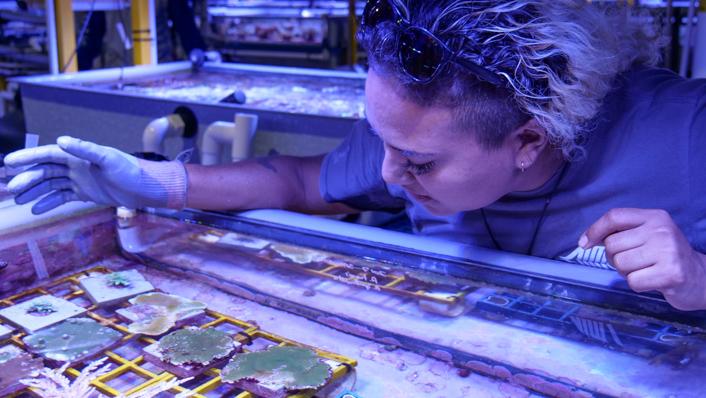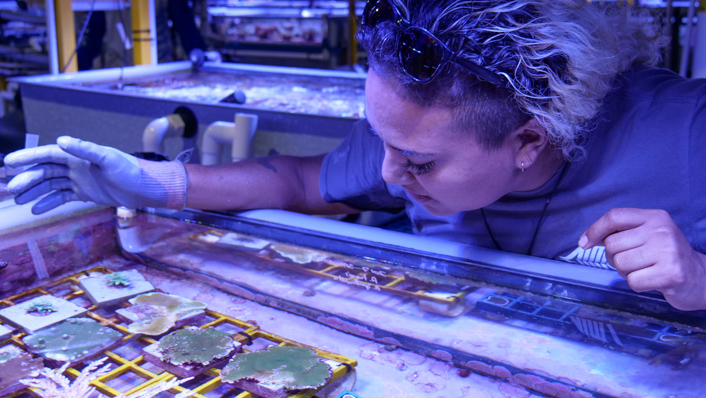AIMS aquaculture trainee and Woppaburra woman Jamiga-Marie Cummins returned to sea Country for coral spawning as part of the Woppaburra Coral Project.
Jamiga was one of two aquaculture assistants supported by the Project, who trained in the National Sea Simulator at AIMS in Townsville. She brought her training to coral spawning in Woppaburra sea Country, on and around Konomie (North Keppel Island), about 15km off the coast of Yeppoon on the southern Great Barrier Reef. Over 40 people were involved in the largest single science and engagement field event in our 50-year history. Jamiga assisted the science team to maintain mobile aquaria systems, larval rearing, settlement and seeding methods. She also joined other Woppaburra Traditional Custodians to share knowledge of marine life, coral spawning, and help with training.
Here is Jamiga’s experience.
What inspired you to apply for the aquaculture trainee program?
I was living in Brisbane and wanted a change in scenery. Aquaculture was completely unknown to me. I said to myself, when was the last time I learnt something new?
The opportunity would also take me closer to home, to sea Country. I saw it as a first step in upskilling Traditional Owners to heal and monitor sea Country.
What part of the trainee program have you enjoyed the most?
Learning about corals, their biology and the environmental simulations that we control to house them.
Understanding the severe sensitivities corals have that affect their survival. Learning about the research depths was intriguing and the incredible adaptation experiments, such as around heat tolerance. Coral hybridisation between parent colonies is one of the most fascinating things I have observed. Coral spawning is quite beautiful to witness, even more so taking part in the unusual methods to manipulate spawning. I learnt how to manipulate environmental cues to trick them to spawn six-months ahead, or behind, their natural spawning window.
What is your connection to Woppaburra sea Country?
My connection to Woppaburra sea Country is via my grandmother, so my dad’s mother, who was born on the beach of Konomie (North Keppel) Island. My great grandmother is Konomie.
Growing up Dad was taught about his father’s side, men’s traditional business and didn’t know much about his mum’s side. But as she got older and after the handback of Konomie Island and Woppa (Great Keppel) Island, my dad encouraged me to learn more about my grandmother. The handback, which was in the mid-2000s became an opportunity for everyone in my family to learn, “What is Woppaburra?” A lot of knowledge was completed for us. Prior to this, I had no connection with Woppaburra.
What did it mean to you, as a Woppaburra woman to be on Country for the coral spawning?
It was pretty powerful to be on sea Country for spawning and with the family. I was there with my nieces and younger family members. They immediately wanted to be involved, wanted to help. They wanted to learn what to do.
For me, it was the first time I had been in a position where I wore two hats, as a Woppaburra woman and as an AIMS' aquarist. The younger generation didn’t always understand what the researchers were doing and why. I was able to break it down, so they could understand what was happening.
It was good for the younger ones to see me wearing two hats. For them to think, “Look what my auntie’s doing. I should have applied for that. I would love to have been involved.” And they did get to be involved. When I was picked for the traineeship, I said to myself I have to commit fully, no matter what. Even though I am going somewhere I have never lived before and going somewhere I don’t know anyone, I have to stick it out. Not for me, but for others. If I don’t complete this, it could be the end of an opportunity like this, and I want others to have this opportunity.
Why is engagement with Traditional Custodians important in the Woppaburra Coral Project?
The big picture would be that this type of opportunity and exchange with AIMS, builds a positive relationship and it gives the Woppaburra people an opportunity to look after their own Country. In future, we may be able to do our own spawning and settling of coral larvae, and to help in the reproduction on the reefs surrounding the islands. It merges the science with the knowledge of the Traditional Custodians.
What future career path / activities are you hoping to pursue because of your experience with AIMS and the Woppaburra Coral Project?
At the end of the traineeship I should have enough experience and skills for a technician position in the National Sea Simulator. I learn faster via hands-on learning. The more experience I have here, the easier it will be for me to complete a formal degree.
Before this, I was always afraid of the ocean. I was really scared of it. It did give me a sense of calm, but always from a distance. Now I have been thrown into ocean life and I don’t want to leave it so soon. There’s so much more to explore, to understand and to learn.
Woppaburra Coral Project partners AIMS and BHP are helping build the skills for the future by supporting Indigenous-identified husbandry technicians.
This program is part of the Australian Coral Reef Resilience Initiative, a partnership between AIMS, BHP and Woppaburra Traditional Custodians.




